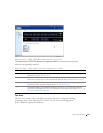
Getting Started 97
Using the CLI
This section contains an introduction to the Command Line Interface (CLI).
Command Mode
The CLI is divided into command modes. Each command mode has a specific command
set. Entering a question mark ? at the system prompt (console prompt) displays a list of
commands available for that particular command mode.
In each mode, a specific command is used to navigate from one command mode to another.
The standards to access the modes are as follows:
• User EXEC Mode
• Privileged EXEC Mode
• Global Configuration Mode
• Interface Configuration Mode
During the CLI session initialization, the CLI mode is the User EXEC Mode. Only a
limited subset of commands are available in the User EXEC Mode. This level is reserved for
tasks that do not change the device configuration and is used to access configuration sub-
systems such as the CLI. To enter the next level, the Privileged EXEC Mode, a password is
required.
The Privileged EXEC Mode provides access to the device general configuration. For specific
global configurations within the device, enter the next level, which is the Global
Configuration Mode. A password is not required.
The Global Configuration Mode manages the device configuration on a global level. For
specific configurations enter the next level, which is the Interface Configuration Mode. A
password is not required.
The Interface Configuration Mode configures the device at the physical interface level.
Interface commands that require subcommands have another level, which is the
Subinterface Configuration Mode. A password is not required.
User EXEC Mode
After the logging on to the device, the User EXEC command mode is enabled. The user
EXEC commands connect to remote devices, change terminal settings on a temporary
basis, perform basic tests, and list system information.


















